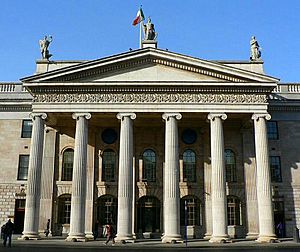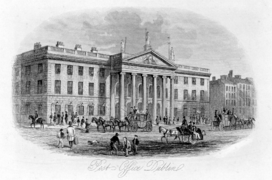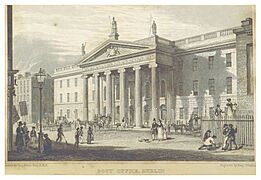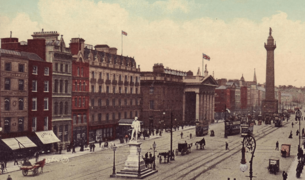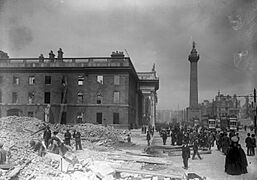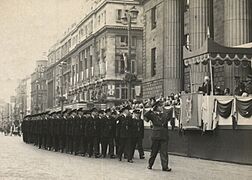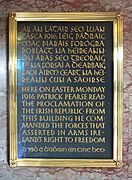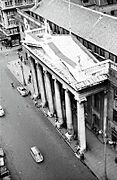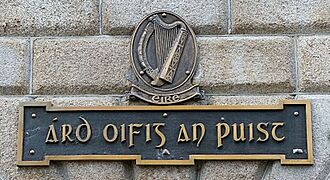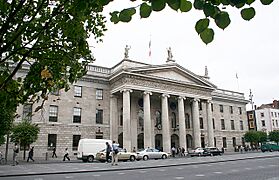General Post Office, Dublin facts for kids
Quick facts for kids General Post Office |
|
|---|---|
|
Ard-Oifig an Phoist
|
|
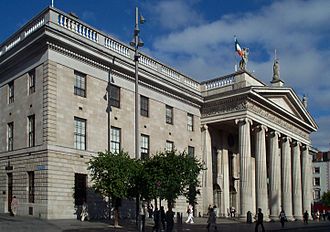
The General Post Office in 2006
|
|
| Alternative names | GPO |
| General information | |
| Type | Post office and administrative offices |
| Architectural style | Greek Revival, neoclassical |
| Location | O'Connell Street Lower Dublin 1 D01 F5P2 |
| Coordinates | 53°20′58″N 6°15′40″W / 53.349334°N 6.261075°W |
| Construction started | 12 August 1814 |
| Inaugurated | 6 January 1818 |
| Cost | 50,000 pounds sterling |
| Owner | Office of public works |
| Design and construction | |
| Architect | Francis Johnston |
The General Post Office (or GPO; Irish: Ard-Oifig an Phoist) is a very famous building in Dublin, Ireland. It used to be the main office for An Post, which is Ireland's postal service. Even today, it's still the main post office in Dublin and is right in the middle of O'Connell Street, a very important street in the city.
The GPO is one of Ireland's most well-known buildings. This is largely because it was the main base for the leaders of the Easter Rising. This was a big event where people fought against British rule in Ireland. The GPO was the last major public building in the Georgian style to be built in Dublin.
Contents
The GPO's Design and Look
The GPO was designed by an architect named Francis Johnston. Its first stone was laid on August 12, 1814. Important people like the Lord Lieutenant of Ireland were there for the ceremony. The building was finished quite quickly, in about three years. It cost between £50,000 and £80,000 to build.
Front of the Building
The front of the GPO is about 67 meters (220 feet) long. It has a large entrance area called a portico. This portico is 24.4 meters (80 feet) wide. It features six tall, fluted Ionic columns. Each column is about 137 centimeters (54 inches) wide.
Above the columns, there's a decorated band called a frieze. The triangular part at the top, known as the pediment, originally had the royal coat of arms. However, these were removed after Ireland gained its independence.
Statues on the Pediment
On top of the pediment, there are three statues created by John Smyth.
- On the left, you'll see Mercury. He is the Roman god of messages and trade, holding his special staff called a Caduceus and a purse.
- On the right is a statue of Fidelity. She represents loyalty and has a dog at her feet. She holds a key in her right hand.
- In the very center is Hibernia. She is a symbol of Ireland, leaning on a spear and holding a harp.
The main part of the building, except for the portico, is made from mountain granite. The portico itself is made from Portland stone. The building has three floors, with the bottom floor looking rough and strong. The grand portico covers the full height of the building.
GPO Arcade
Behind the main GPO building, there's a shopping area called the GPO Arcade. It has a cool art deco style. You can enter it from Henry Street and Princes Street North. This arcade was built after the Easter Rising.
A Look Back: GPO's History
The General Post Office in Ireland has moved several times over the years. It started in High Street, then moved to Fishamble Street, and later to other spots in Dublin. Finally, on January 6, 1818, the new and current GPO building on Sackville Street (now O'Connell Street) opened its doors for business.
The Easter Rising
The GPO played a huge role in the Easter Rising of 1916. It became the main headquarters for the leaders of the rebellion. On April 24, 1916, Patrick Pearse stood outside this very building. He read out the Proclamation of the Irish Republic, declaring Ireland's independence.
During the fighting, the GPO was badly damaged by fire. Only its strong granite front survived. The building was rebuilt by the Irish Free State government and reopened in 1929.
Symbols and Memorials
The GPO has remained a powerful symbol of Irish nationalism. In 1935, a special statue was placed inside the GPO's main hall. It shows the mythical Irish hero Cúchulainn at the moment of his death. This statue, made by Oliver Sheppard in 1911, honors the Easter Rising. It even appeared on the Irish ten shilling coin in 1966, marking 50 years since the Rising.
Interestingly, for many years, rent for the GPO building was still paid to landlords in England and America. This continued until the 1980s!
Broadcasting and Modern Times
The first radio studios for 2RN, which later became Radio Éireann, were located at the GPO. They broadcast from there between 1928 and 1974. Today, the weekly draws for Prize Bonds still happen in the building every Friday.
Near the GPO, in the middle of O'Connell Street, used to stand Nelson's Pillar. This tall monument was destroyed by an explosion in 1966. In 2003, the Spire of Dublin was built on the same spot.
In 2016, a special 2 euro coin was made to celebrate 100 years since the Easter Rising. It featured the statue of Hibernia from the GPO.
In June 2023, the main offices of the postal service An Post moved from the GPO building to a new location in Dublin. However, the GPO still remains a very important and historic post office.
Images for kids
-
Before independence, with a British flag flying. The hotel next door was destroyed in 1916.
-
The GPO after the Rising; Nelson's Pillar can be seen on the right.
See also
 In Spanish: Oficina General de Correos de Dublín para niños
In Spanish: Oficina General de Correos de Dublín para niños


